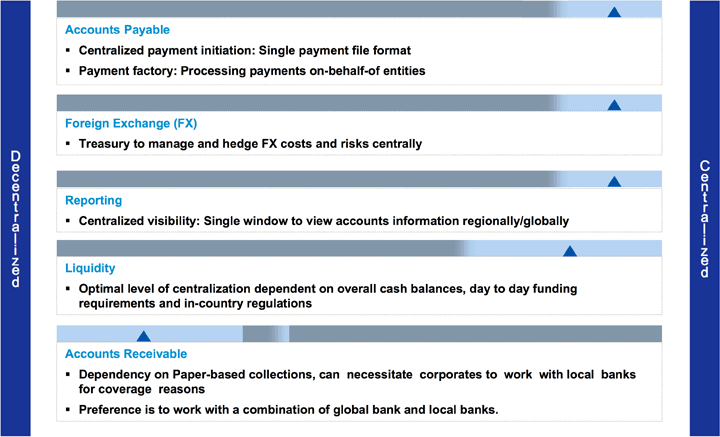
Multinational Corporate Trends in Asia

|
By |
In the post financial crisis corporate environment in Asia, we see an increasing emphasis on three key strategies: centralization, automation and standardization.
Centralization strategies focus on alignment of operations with select strategic bank partners, a regional approach to treasury and an emphasis on integrated working capital management, with liquidity being the key driver. An increasing level of automation investment is aimed at creating seamless workflow between key treasury operations such as payments, foreign exchange, intercompany loans and investments. Lastly, corporates are seeking to take advantage of significant standardization opportunities afforded by SWIFT, as well as harmonized regional solutions offered by global banks.
These three key strategies — centralization, automation and standardization — are leading to further "regionalization" of treasury.
Asia Pacific Regionalization
What are global companies looking to achieve via regionalization in Asia? Operational efficiency and counterparty risk management are the main goals, followed by cost reduction and liquidity. By combining regional strategies with complementary sub-regional and country level strategies that address local nuances, best-in-class treasuries are able to achieve significant regionalization despite the wide market diversity in Asia.
Five Areas of Centralization

Next Generation Treasury Solutions in Asia
RMB Offshore. No discussion of "what is new" in Asia today would be complete without talking about renminbi (RMB) internationalization. Since its launch in 2010 there has been significant interest and market uptake around this exciting new currency. Multinational corporations are now able to conclude both imports and exports in RMB to all areas in China. Corporates can open an RMB Offshore account and have the choice to use these RMB funds for further trade and to maintain or sell into other currencies.
Chinese corporations are now capable of importing in RMB. Corporates can settle import of goods, cross-border service trade and other current account items in RMB. Additionally, the recent waiver of the Mainland Designated Enterprise (MDE) status requirement for Chinese exporters in order to accept RMB is expected to lead to further major growth in RMB acceptance for Chinese export settlements.
What's next? Expansion of clearing services beyond Hong Kong into London and Singapore is anticipated. This will enable global pooling of offshore RMB for companies that maintain such accounts in multiple global locations.
It is important to carefully examine your company's inward and outward flows in RMB related to trade, open accounts and dividend or royalty payments. This will help evaluate possible benefits and develop an offshore RMB implementation strategy together with your transaction bank.
SWIFT XML. Another key trend in Asia is SWIFT adoption. The increasing levels of standardization made possible by XML ISO 20022, coupled with the improving cost dynamics of SWIFT for Corporates (SCORE) Solutions, are expected to push adoption beyond the "tipping point." Although only 10% of the 900 corporates on SWIFT today come from Asia (compared to 72% in EMEA and 18% in the US), these statistics should change once the key implementation obstacles are removed.
XML 2nd Version Messages (pain.001.001.02, pain.008.001.01, pain.002.001.02) have been live in the market since 2007 and are available and continue to be supported at Deutsche Bank. 3rd Version Messages (pain.001.001.03, pain.008.001.02, pain.002.001.03) were published by ISO in April 2009 and are pending implementation by major banks in 2011/2012. If you have not already done so, together with your transaction banker you can examine how SWIFT can add value to your Asian operations.
Asia: Best Practices
Thriving in the complex Asian environment requires treasurers to create an optimal mix of regional and local strategies within the overarching context of their global treasury strategy.
At the global level, companies define their core philosophies around centralization, automation and standardization. On the regional level, banking innovations are available that best address regional needs, such as SWIFT. From a local perspective, it is imperative to include country-specific solutions, such as RMB Offshore in China or Check Collections in India, that take advantage of best market practices. When it comes to Asia, it is all about managing diversity within your overarching global treasury strategy.
View other articles in this edition SEPA Preparations Take on Urgency Following Decision on End DateBilateral Standby Letter of Credit Facility Can Free Up Working Capital
Client-Centric Design Principles Drive Development of Access Products
| Download a PDF |
| Comment on This Story |
| Suggest a Topic |
| Related Articles |
| Treasury Solutions in Asia Can Begin in One Country |
| Current Edition |
| Previous Editions |
| Visit Our Web Site |
| Conferences |
|
EuroFinance International Cash and Treasury Management May 9-11 Miami, FL |
| Recent Awards |
|
Euromoney Trade Finance Survey 2012 • No. 1 Trade Finance Provider - US • No. 1 Trade Finance Provider - Brazil |